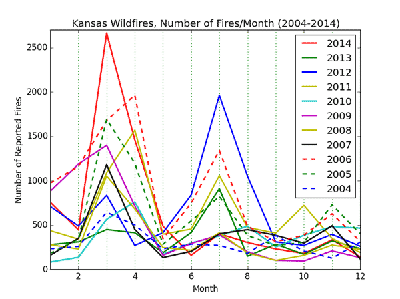Number of Kansas Wildfires Spikes in Spring
The state recorded almost 6,000 vegetation-related fires last year.
The coming spring holds the promise of longer, warmer days, but it also marks the time when the number of wildfires typically peaks in Kansas.
Wildfires in Kansas don’t usually make the national news the way they do in California or other states, but they can be just as destructive, said Chip Redmond, network manager of the Kansas Mesonet and Kansas Weather Data Library at Kansas State University.
Kansas fire departments responded to nearly 6,000 vegetation-related fires that resulted in more than $4.8 million in property loss in 2015 alone, according to the Kansas Department of Emergency Management.
Gov. Sam Brownback has designated Feb. 22-26, 2016, as Wildfire Awareness Week in Kansas.
“Any one of us can cause a wildfire without realizing it,” Redmond said, noting that cigarette butts, car exhaust and burning trash are among some of the most common ways wildfires can start. When ignition sources like that come into contact with dried grass, brush, leaves and other materials that are easy to ignite, the chances of a fire are even greater. There may also be a correlation with the time some landowners are doing planned or prescribed burns on their property, to reduce brush and tree growth and encourage native plant growth.
Redmond analyzed data from the first 11 years (2004-2014) the Kansas Fire Incident Reporting System has been keeping records on wildfires and other types of fires. His work showed that a record 8,075 wildfires were reported in 2014. The land area burned, 187,000 acres, was also a record high. In both land area and number, fires followed the typical curve of the previous 10 years, with a peak during the spring months of March and April.
The spring wildfire trend coincides with the time of year prescribed burning occurs in parts of Kansas, Redmond said. Early spring is typically characterized by dead or cured fuels (wood and brush), warming temperatures, low relative humidity and little precipitation.
“Often, if the late fall and winter are below normal in precipitation or the region is in a drought, these spring conditions are enhanced, providing explosive conditions for fire growth, which is what happened in 2014,” he said.
Most of the fires in 2014 did not occur on days that the National Weather Service deemed Red Flag Warning (RFW) days. RFWs are triggered by the combination of fuels that are cured or dead, winds forecast at greater than 15 mph and relative humidity at less than 20% — all for three or more hours.
“With the majority of fires and acreage burned occurring on non-RFW days (in 2014), additional research is required to evaluate why these fires are happening,” Redmond said. It may indicate the need for better thoroughness of reporting cause, size and circumstance of each wildfire; higher resolution of weather data; social aspects of prescribed burning; or the evaluation of the lack of fires on RFW days.
More information about Redmond’s wildfire weather analysis is available at https://webapp.agron.ksu.edu/agr_social/eu_article.throck?article_id=761.
Kansas State University and K-State Research and Extension are part of the Kansas Interagency Wildfire Council, a coalition of state and federal agencies with the goal of providing an integrated approach to fire management.








